You can spot beryllium-treated sapphires by examining their unusually intense yellow-orange colors with uneven distribution patterns, especially concentrated on the pavilion. Look for distinctive circular “Saturn” inclusions under 30-70x magnification and altered silk patterns that differ from natural stones. Test with methylene iodide immersion to reveal color zoning, check for bright orange-yellow fluorescence under UV light, and be wary of suspiciously low prices. These techniques will help you uncover the subtle signs that reveal treatment.
Examine Color Intensity and Distribution Patterns
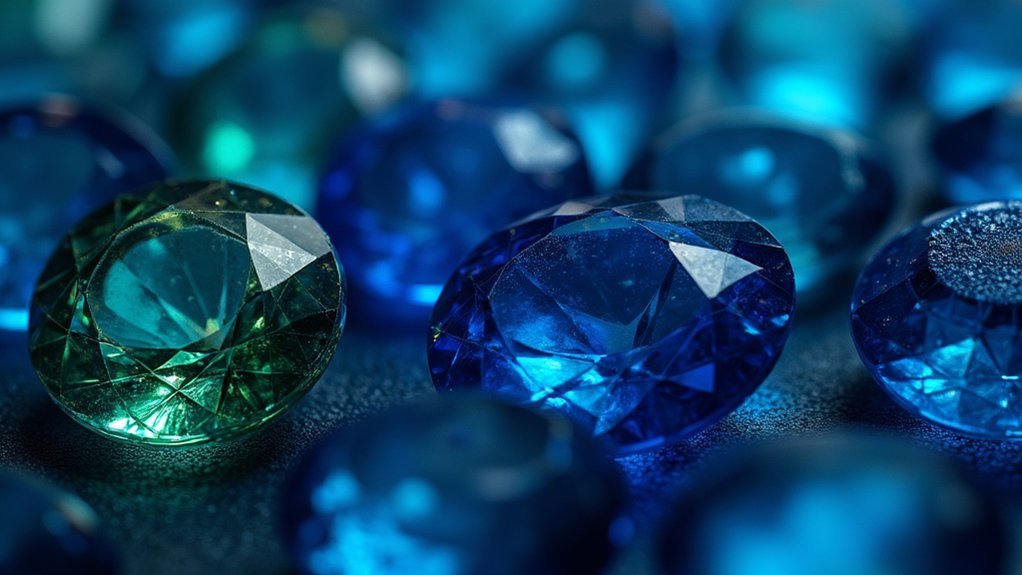
One of the most telling signs you’ll notice in beryllium-treated sapphires is their unusually intense color saturation, particularly in bright yellows and oranges that rarely occur naturally.
When you examine these stones carefully, you’ll observe that the color distribution isn’t uniform throughout the gem. Instead, beryllium treatment creates a concentration of color on the pavilion, where the diffusion process penetrates the stone’s surface.
You should also look for distinctive color zoning patterns that appear as irregular bands or patches.
These zones differ markedly from the natural color variations found in untreated sapphires. The artificial enhancement creates sharper color boundaries and more dramatic shifts between different saturation levels.
Artificial enhancements produce stark color transitions that contrast sharply with the subtle, gradual variations characteristic of natural sapphires.
This uneven distribution serves as a reliable indicator when identifying treated sapphires during your gemological examination.
Inspect Internal Inclusions Under Magnification
When examining suspected beryllium-treated sapphires under high magnification (30x to 70x), you’ll discover distinctive circular or round inclusions that result directly from the treatment process.
These inclusions often appear as thin films or clouds of silk, markedly different from the typical rutile silk found in untreated stones.
Look for irregular or destroyed patterns that aren’t characteristic of standard heat treatment, which usually displays well-defined inclusions.
During beryllium diffusion treatment, internal crystals develop jagged edges from lower heating temperatures, providing essential evidence of treatment history.
In contrast, well-defined needles or silk typically indicate an unheated stone.
Compare the overall inclusion pattern against known characteristics of both treated and untreated sapphires.
This systematic approach will give you vital clues for identifying beryllium treatment.
Perform Methylene Iodide Immersion Testing
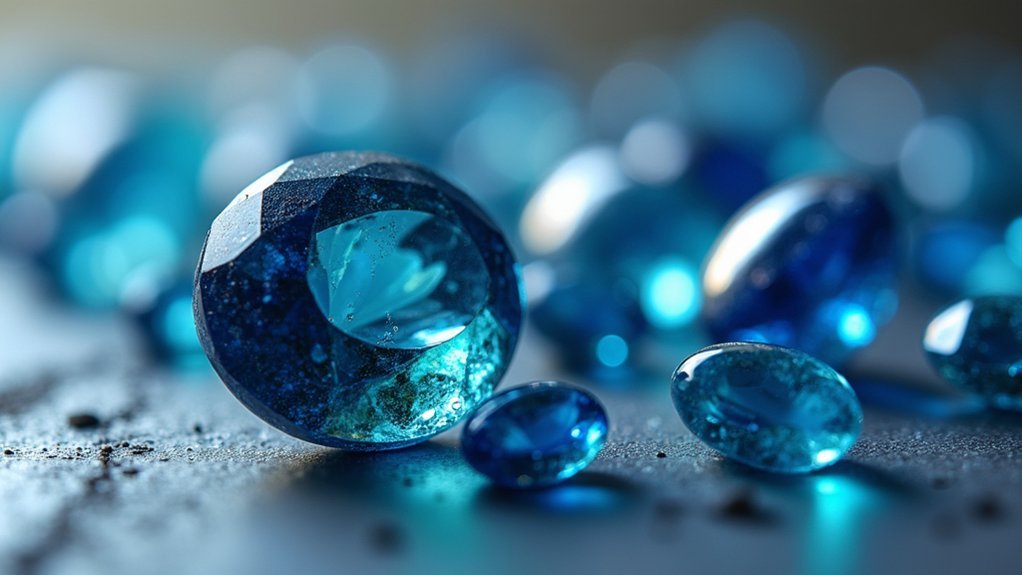
You’ll need to prepare methylene iodide at the correct density of 1.7 g/cm³ to create an effective testing solution for detecting beryllium treatment.
When you submerge the sapphire, watch carefully for any color changes or concentrated zones that appear different from the stone’s overall hue.
The immersion reveals how treatment has penetrated the surface by showing distinct color rinds or zoning patterns that aren’t visible in normal lighting conditions.
Testing Solution Properties
Several immersion tests can help reveal the telltale signs of beryllium treatment in sapphires, with methylene iodide testing being among the most effective.
This testing method relies on methylene iodide’s specific gravity of 3.33 to create ideal viewing conditions for detecting beryllium treated stones. When you submerge a sapphire in this solution, you’ll notice enhanced visibility of internal characteristics that aren’t apparent under normal lighting.
The solution’s refractive properties allow you to spot distinct color zoning or uniformity issues typical of treated stones. You’ll particularly want to watch for yellow or orange rims around the sapphire’s edges, which indicate potential beryllium diffusion.
Always repeat the immersion multiple times to confirm your observations, as treatment patterns can vary considerably between stones.
Color Concentration Detection
As you perform the methylene iodide immersion test, focus specifically on detecting color concentration patterns that reveal beryllium treatment signatures.
Watch carefully for pronounced color rims or rinds appearing on the stone’s surface during immersion testing. These distinctive patterns indicate beryllium diffusion has occurred, as the treatment creates uneven color distribution throughout the sapphire.
The methylene iodide’s specific gravity allows you to observe how color penetrates and distributes within the stone.
You’ll notice color concentration differences that standard gemological tests often miss. Look for color zoning or irregular saturation patterns that suggest artificial enhancement rather than natural formation.
This immersion testing method’s effectiveness lies in revealing subtle variations in color concentration that differentiate treated stones from untreated specimens, providing enhanced accuracy in identifying beryllium-enhanced sapphires.
Surface Penetration Analysis
Building on the color concentration patterns you’ve identified, surface penetration analysis through methylene iodide immersion reveals the precise depth and distribution of beryllium treatment within your sapphire.
When you immerse your stone in methylene iodide, distinct color rims or rinds appear on treated surfaces due to differing refractive indices between the beryllium-treated layer and the immersion liquid.
You’ll need magnification to observe subtle color changes that indicate surface diffusion depth. Untreated sapphires won’t display these characteristic color zones.
Conduct this testing in a controlled environment to prevent contamination and guarantee accurate results.
The visual contrast created by the methylene iodide allows you to confirm beryllium treatment definitively, making this method essential for authentication.
Look for Circular or Ring-Like Saturn Inclusions

When examining sapphires under high magnification, you’ll want to search for distinctive circular or ring-like inclusions called Saturn inclusions, which serve as telltale signs of beryllium treatment.
These characteristic formations typically develop in areas where natural silk inclusions have been altered or destroyed during high-temperature diffusion processes. You’ll need magnification between 30x to 70x to accurately identify these ring-shaped features and distinguish them from other inclusion types.
Saturn inclusions appear less frequently in untreated stones, making their presence a strong indicator that the sapphire was treated with beryllium.
When you spot these circular patterns, they suggest the stone underwent beryllium diffusion, which altered both its color and clarity. Careful observation of these inclusions provides vital evidence for identifying beryllium-enhanced sapphires.
Check for Unusual Fluorescence Characteristics
When you examine a sapphire under ultraviolet light, beryllium-treated stones often reveal themselves through distinctly different fluorescence behavior than their natural counterparts.
You’ll notice treated sapphires typically emit a bright orange or yellow glow under long-wave UV light, while untreated stones usually show weak or no fluorescence at all.
Watch for uneven fluorescence distribution patterns across the stone’s surface, as this irregular response can signal beryllium treatment and help you distinguish authentic from enhanced gems.
UV Light Response
Under ultraviolet light, beryllium-treated sapphires reveal telltale signs that can help you identify their enhanced nature.
You’ll notice these stones display unusually bright orange or yellow fluorescence, contrasting sharply with untreated sapphires that typically show subtle blue glows. This fluorescence pattern also applies to beryllium diffusion of ruby treatments.
Test your stones under both long-wave and short-wave UV light, as treated gems often exhibit different colors or intensities under each type.
You’ll want to immerse suspected stones in methylene iodide solution to highlight inconsistent fluorescence patterns or color zoning that beryllium treatment creates.
Watch for overly intense, consistent fluorescence in stones that appear suspiciously vibrant or perfect—this combination often indicates beryllium enhancement requiring professional verification.
Color Change Patterns
Beyond standard fluorescence testing, you’ll need to examine how beryllium-treated sapphires shift colors under different lighting conditions to reveal their artificial enhancement.
Color change patterns in beryllium-diffused stones often display dramatic differences between surface and core areas when viewed under UV light. You’ll notice the fluorescence becomes more pronounced at the stone’s surface, creating visible color variations that don’t occur naturally.
Look for bright yellow or orange hues that appear unusually intense compared to untreated sapphires. These color change patterns indicate beryllium diffusion treatment has altered the stone’s natural properties.
When you immerse suspected stones in methylene iodide, the fluorescence patterns become even more distinct, showing clear demarcation between treated surface layers and the original core material underneath.
Analyze Price Points Against Market Standards
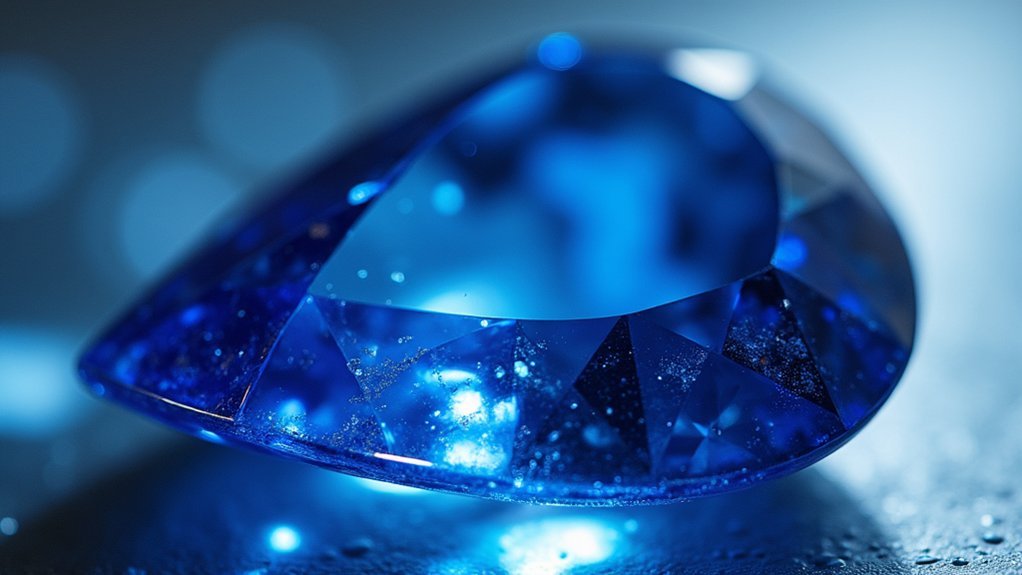
Since beryllium-treated sapphires typically sell for 30% to 50% less than their untreated counterparts, price comparison serves as your first line of defense against unknowingly purchasing treated stones.
You’ll notice untreated sapphires with vibrant colors command premium prices, often exceeding thousands of dollars per carat. Market trends show untreated sapphires are increasingly sought after, driving their prices higher while beryllium-treated sapphires remain considerably less valuable.
Be especially cautious of deals that seem too good to be true, particularly for bright yellows and oranges. These colors are naturally rare in untreated stones, so suspiciously low prices may indicate treatment.
Always compare similar stones across multiple dealers to establish realistic market benchmarks before making your purchase decision.
Seek Professional Laboratory Analysis With Advanced Testing
While price analysis provides valuable initial screening, you’ll need definitive laboratory confirmation to verify a sapphire’s treatment status.
Professional laboratory analysis using advanced testing methods is essential for accurately detecting beryllium-treated sapphires, as standard gemmological techniques often fall short due to the treatment’s deep penetration.
Advanced laboratory testing proves crucial for detecting beryllium-treated sapphires since conventional gemological methods cannot penetrate deep enough for accurate identification.
Specialized labs employ LA-ICP-MS (Laser Ablation Inductively Coupled Plasma Mass Spectrometry) and SIMS (Secondary Ion Mass Spectrometry) to identify beryllium content down to a few parts per million.
These sophisticated methods reliably assess treatment status by detecting foreign elements within the stone.
During evaluation, professionals inspect for high-temperature heat treatment signs, altered inclusions, and unusual fluorescence patterns.
Reputable laboratories like GIA and AGTA GTC have implemented rigorous testing protocols, ensuring market integrity and providing you peace of mind when purchasing gemstones.
Frequently Asked Questions
How to Tell if Sapphire Is Beryllium Treated?
You’ll notice unusually vibrant yellow-orange colors and irregular inclusions under magnification. Check for surface color differences using methylene iodide immersion. Suspiciously low prices often indicate treatment, requiring advanced LA-ICP-MS testing for confirmation.
How to Tell if a Sapphire Has Been Heat Treated?
You’ll examine internal inclusions under magnification, looking for dissolved silk formations, discoid inclusions, or altered inclusion patterns. Check for improved clarity and color uniformity that indicates exposure to high temperatures during treatment.
How Much Is Beryllium Treated Sapphire Worth?
You’ll find beryllium-treated sapphires worth considerably less than untreated stones, typically selling for 30-50% below market value. Expect prices ranging from $100-500 per carat versus thousands for natural sapphires.
Can a Jeweler Tell if a Sapphire Is Lab Created?
Yes, you’ll find that jewelers can identify lab-created sapphires through their flawless appearance, distinctive growth patterns under magnification, spectroscopy testing, considerably lower prices, and certification from gemological laboratories verifying their synthetic origin.
In Summary
You can’t rely on a single method to identify beryllium-treated sapphires. You’ll need to combine visual inspection, magnification techniques, and fluorescence testing for initial assessment. Don’t forget to compare prices against market standards—unusually low costs often signal treatment. However, you shouldn’t make final purchasing decisions without professional laboratory analysis. Only advanced spectroscopic testing can definitively confirm beryllium treatment, protecting your investment and ensuring you’re getting what you’re paying for.

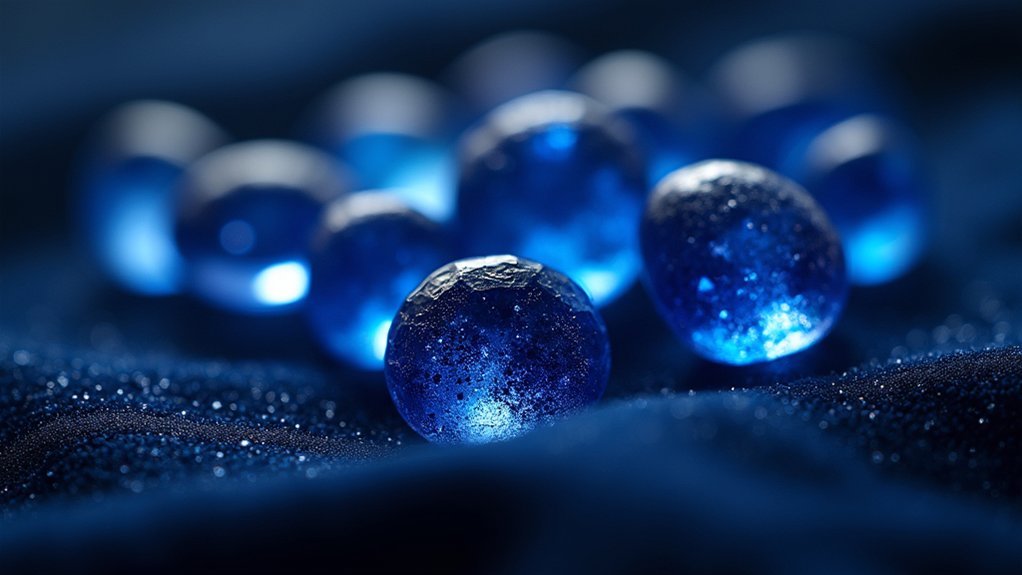
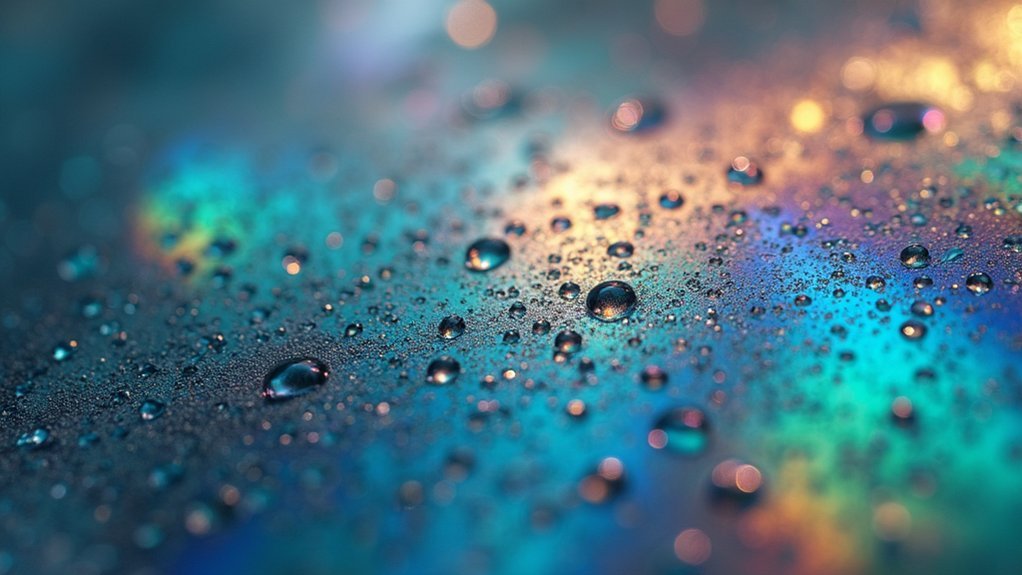
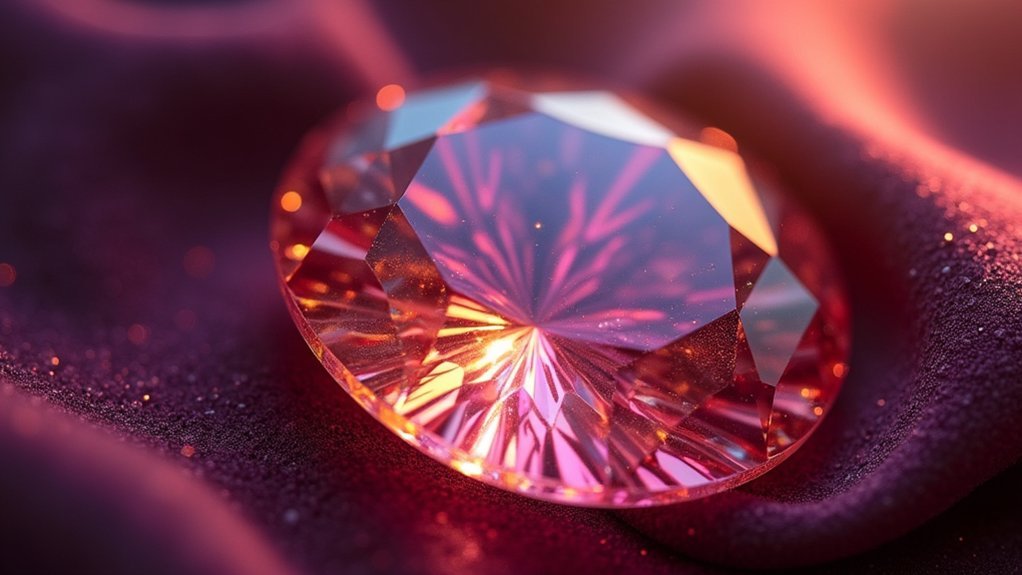
Leave a Reply